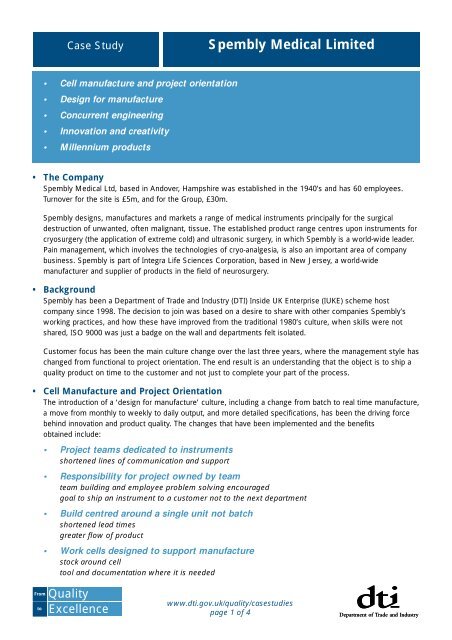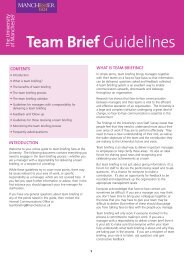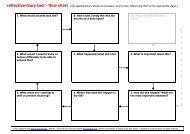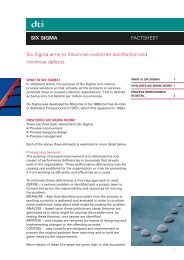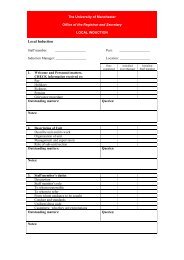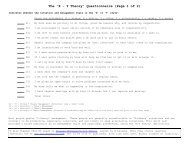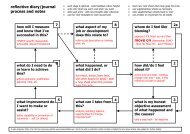Spembly Medical Limited case study - Businessballs
Spembly Medical Limited case study - Businessballs
Spembly Medical Limited case study - Businessballs
Create successful ePaper yourself
Turn your PDF publications into a flip-book with our unique Google optimized e-Paper software.
Case Study<strong>Spembly</strong> <strong>Medical</strong> <strong>Limited</strong>• Cell manufacture and project orientation• Design for manufacture• Concurrent engineering• Innovation and creativity• Millennium products• The Company<strong>Spembly</strong> <strong>Medical</strong> Ltd, based in Andover, Hampshire was established in the 1940’s and has 60 employees.Turnover for the site is £5m, and for the Group, £30m.<strong>Spembly</strong> designs, manufactures and markets a range of medical instruments principally for the surgicaldestruction of unwanted, often malignant, tissue. The established product range centres upon instruments forcryosurgery (the application of extreme cold) and ultrasonic surgery, in which <strong>Spembly</strong> is a world-wide leader.Pain management, which involves the technologies of cryo-analgesia, is also an important area of companybusiness. <strong>Spembly</strong> is part of Integra Life Sciences Corporation, based in New Jersey, a world-widemanufacturer and supplier of products in the field of neurosurgery.• Background<strong>Spembly</strong> has been a Department of Trade and Industry (DTI) Inside UK Enterprise (IUKE) scheme hostcompany since 1998. The decision to join was based on a desire to share with other companies <strong>Spembly</strong>’sworking practices, and how these have improved from the traditional 1980’s culture, when skills were notshared, ISO 9000 was just a badge on the wall and departments felt isolated.Customer focus has been the main culture change over the last three years, where the management style haschanged from functional to project orientation. The end result is an understanding that the object is to ship aquality product on time to the customer and not just to complete your part of the process.• Cell Manufacture and Project OrientationThe introduction of a ‘design for manufacture’ culture, including a change from batch to real time manufacture,a move from monthly to weekly to daily output, and more detailed specifications, has been the driving forcebehind innovation and product quality. The changes that have been implemented and the benefitsobtained include:• Project teams dedicated to instrumentsshortened lines of communication and support• Responsibility for project owned by teamteam building and employee problem solving encouragedgoal to ship an instrument to a customer not to the next department• Build centred around a single unit not batchshortened lead timesgreater flow of product• Work cells designed to support manufacturestock around celltool and documentation where it is neededFromtoQualityExcellencewww.dti.gov.uk/quality/<strong>case</strong>studiespage 1 of 4
Project management techniques, including the creation of Project Champions, together with real managementownership of ISO 9000 procedures, have also driven the quality initiatives.A system of cellular manufacturing is now operated, where cells are designed to fully support a product, withthe emphasis on flow and ease of manufacture. Critical path analysis is applied to flow, bottlenecks areanalysed and all processes are challenged to ensure that they add value. The advantages of cell manufacturingthat have been experienced by <strong>Spembly</strong> include:• Reduced Working Time• Reduce Response Time• Increased Ownership• Reduced Costs• Concurrent Engineering<strong>Spembly</strong> was determined to reinvent, from top to bottom, the way they did things. The introduction ofconcurrent engineering techniques was typical of the new capabilities acquired in the course of developingand bringing the microsurgical handpiece to market. It involves:• Structured stage-gated process• Implement tasks simultaneously• Identify & fully specify all tasks• Assign responsibilities• Hold regular reviews• Identify problems & attack them• Share information• Work as a team & ‘live’ the projectAnd the benefits to be obtained are:– Increased communication– Greater understanding– Ownership & involvement– Shared success…….. shared problems– Improved quality– Compressed development cycle– Innovative ideas & solutionsAs Managing Director, Patrick Sparkes, commented, “It is important to regard key customers as part of thedevelopment team, to scan widely for the best new technical solutions, to nurture a dynamic culture ofinnovation, so that people don’t just follow the process but actually ‘live it’, and to listen to users, includingolder, existing users to gain actionable feedback”.FromtoQualityExcellencewww.dti.gov.uk/quality/<strong>case</strong>studiespage 2 of 4
A culture of “Try it and see if it works” with problem solving techniques, empowering employees, removingthe fear element of getting it wrong and encouraging ownership at all levels is at the heart of a desire to see‘continuous improvement’.• The ResultsAs a result of introducing concurrent engineering, <strong>Spembly</strong> has the following results:• Unique gas socket design• Patented gas engine• Novel probe design• Modern manufacturing processes• Documentation complete at product launch• Ownership• OwnershipIn addition, <strong>Spembly</strong> was a finalist in the Management Today Innovation Awards for innovation in productdesign for its ultrasonic microsurgical handpiece for neurosurgeons. The objective of the awards was not torecognise excellence in the design of specific products, nor to laud their financial impact on marketintroduction, but to take a holistic look at how companies innovate, using individual projects to provide a‘window’ on the management of the development process.The judges were particularly impressed by the linkages between development and the senior managementteam, how the culture and environment of the firm supported innovation and the way in which the project hadallowed <strong>Spembly</strong> to develop new capabilities, such as software tools.Success in the Management Today awards and the knock-on benefit to staff morale encouraged the companyto apply for Millennium Product status for two of its products. Launched by the government in 1998, and runin conjunction with the Design Council, Millennium Products was the nationwide search for the country’s mostinnovative products and services.• The Future<strong>Spembly</strong> is very conscious that fast change can often create hidden problems. Therefore, there is an activepolicy to keep reviewing what has been achieved and to revisit the goal. In 1995 the goal was very easy tocommunicate, the need for improvement was obvious, but now that backorders are virtually zero andrework/customer returns are extremely low, it is vital to not let complacency creep in.<strong>Spembly</strong> continues to use the DTI’s IUKE scheme to visit or re-visit other host companies, and from this thereis always some new angle on an old way of working. As Patrick Sparkes said, “Having a tangible goal is vital,something that people can strive for, that they will be proud to achieve. <strong>Spembly</strong>’s tangible goal was toachieve recognition by the IUKE scheme and be invited to join”FromtoQualityExcellencewww.dti.gov.uk/quality/<strong>case</strong>studiespage 3 of 4
Having been acquired by Integra LifeSciences, its first acquisition outside the USA, <strong>Spembly</strong>’s new goal is tobe the best within the new company. Specific targets to achieve this will be to:• Have better customer service• Have better sales response• Have the best turn around times for repairs and servicing.If it can achieve this, and all of those can be objective, with realistic targets set, then <strong>Spembly</strong> will be thenatural choice for spearheading further growth into the European market and thus further investment for newproducts and services.Like a new product, this goal is treated as a project, and many of the concurrent engineering techniquescan be applied.<strong>Spembly</strong> will also continue to look for public recognition of its achievements, such as the Management Todaysponsored award, or the Queen's Award for Enterprise. These naturally allow processes to be benchmarked,and lead to improvement activities.FromtoQualityExcellencewww.dti.gov.uk/quality/<strong>case</strong>studiespage 4 of 4


